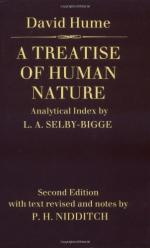We may apply the same reasoning to curve and right lines. Nothing is more apparent to the senses, than the distinction betwixt a curve and a right line; nor are there any ideas we more easily form than the ideas of these objects. But however easily we may form these ideas, it is impossible to produce any definition of them, which will fix the precise boundaries betwixt them. When we draw lines upon paper, or any continued surface, there is a certain order, by which the lines run along from one point to another, that they may produce the entire impression of a curve or right line; but this order is perfectly unknown, and nothing is observed but the united appearance. Thus even upon the system of indivisible points, we can only form a distant notion of some unknown standard to these objects. Upon that of infinite divisibility we cannot go even this length; but are reduced meerly to the general appearance, as the rule by which we determine lines to be either curve or right ones. But though we can give no perfect definition of these lines, nor produce any very exact method of distinguishing the one from the other; yet this hinders us not from correcting the first appearance by a more accurate consideration, and by a comparison with some rule, of whose rectitude from repeated trials we have a greater assurance. And it is from these corrections, and by carrying on the same action of the mind, even when its reason fails us, that we form the loose idea of a perfect standard to these figures, without being able to explain or comprehend it.
It is true, mathematicians pretend they give an exact definition of a right line, when they say, it is the shortest way betwixt two points. But in the first place I observe, that this is more properly the discovery of one of the properties of a right line, than a just deflation of it. For I ask any one, if upon mention of a right line he thinks not immediately on such a particular appearance, and if it is not by accident only that he considers this property? A right line can be comprehended alone; but this definition is unintelligible without a comparison with other lines, which we conceive to be more extended. In common life it is established as a maxim, that the straightest way is always the shortest; which would be as absurd as to say, the shortest way is always the shortest, if our idea of a right line was not different from that of the shortest way betwixt two points.
Secondly, I repeat what I have already established, that we have no precise idea of equality and inequality, shorter and longer, more than of a right line or a curve; and consequently that the one can never afford us a perfect standard for the other. An exact idea can never be built on such as are loose and undetermined.




